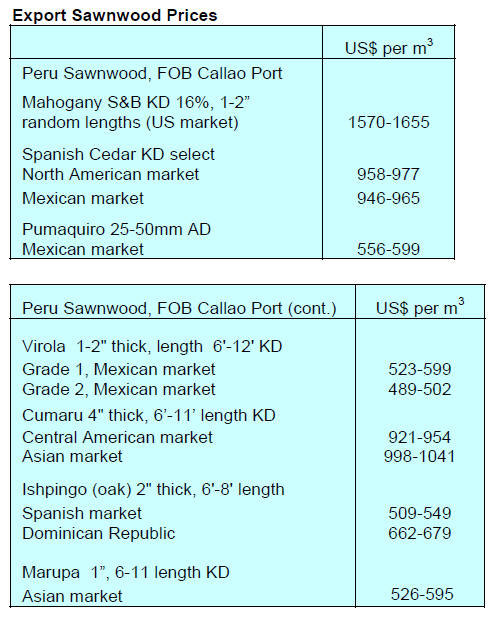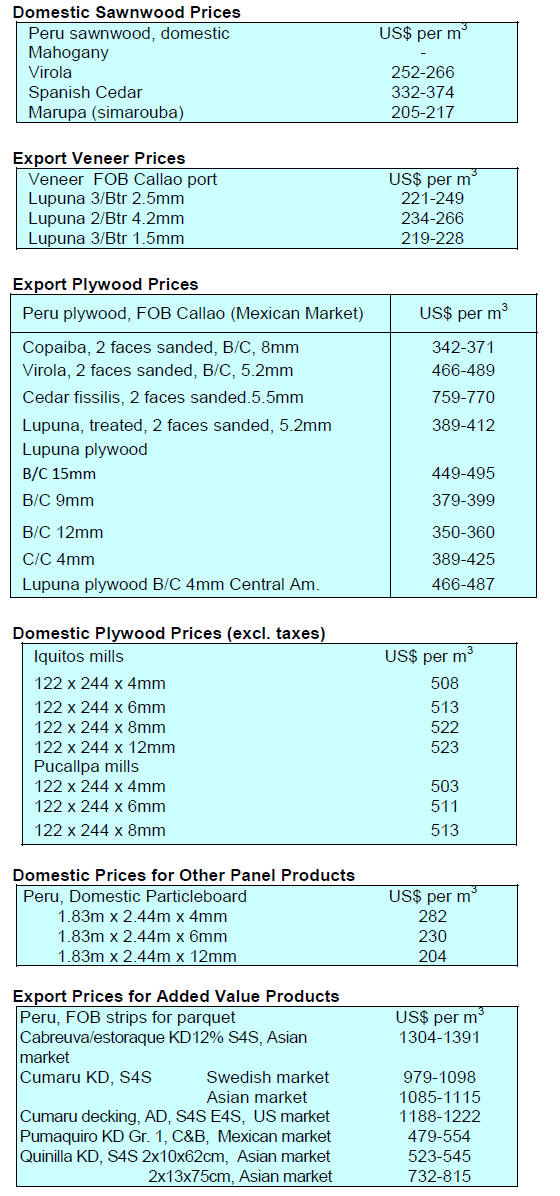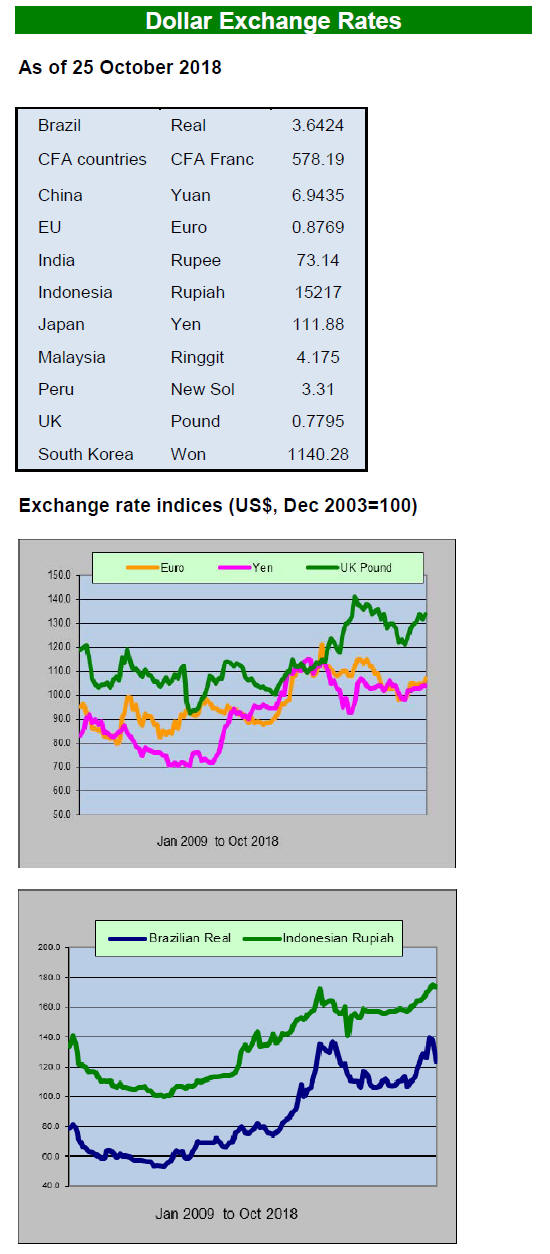2.
MALAYSIA
Export earnings dip due to bad
weather
Between January and August this year Malaysia’s wood
product exports declined almost 6% to RM14.6 bil.
compared to the same period last year. Analysts write that
this was mainly due to bad weather which hampered
harvesting and production.
Despite this decline, Malaysian Timber Council (MTC)
chairman, Low Kian Chuan, said the Council was
confident of achieving the 2018 export target.
Low said the main export earners were wooden furniture,
plywood, sawnwood, fibreboard and joinery products.
Marketing mission to Philippines
The Malaysian Timber Industry Board (MTIB) recently
arranged mission to the Philippines under the MTIB
‘Technical Mission and Timber Entrepreneurs
Development Programme’. The aim was to expand trade
in Malaysian wood products, particularly of high valueadded
value wood products.
In 2017, Malaysia’s wood product exports to the
Philippines were worth RM734 million. Sawnwood was
the main item exported and there has been a steady
increase in sawnwood exports to the Philippines since
2013. Other major products exported to the Philippines
include wooden furniture and plywood which in 2017
were worth RM183 and RM49.6 million respectively.
While furniture exports increased last year plywood
exports fell compared to levels in previous years.
Malaysian imports of wood products from the Philippines
were valued at RM7.4 mil. last year and comprised mainly
rattan and wooden furniture.
Landmark effort between Forestry Department and oil
palm plantation owners in Sabah
The Sabah Forestry Department recently held a landmark
meeting with key oil palm plantation owners to discuss the
Department’s EU-funded REDD-plus project "Tackling
Climate Change through Sustainable Forest Management
and Community Development."
This was the first ever meeting with a group of plantation
owners and also for the EU-REDD+ project. The aim was
to find common ground for forest conservation efforts in
the Upper Kinabatangan River corridor.
Plantation owner, Sawit Kinabalu Berhad manages the
Sungai Pin Conservation area. Here forest restoration
work is undertaken by the RiLeaf Project, the Pongo
Alliance and Bora who are building a resilient habitat for
Orang Utangs. The objective of the EU-REDD+ project is
to contribute to the sustainable and low carbon
development of Sabah.
Plywood prices
Traders based in Sarawak reported the following plywood
export prices for mid-October:
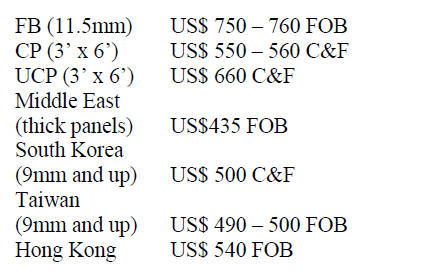
3.
INDONESIA
Indonesian Timber Council
(ITC) launched
A new institution, the Indonesian Timber Council (ITC)
has been launched bringing together seven associations,
namely ILWA, ISWA, APHI, APKINDO, APKI,
ASMINDO and HIMKI.
The functions of the new Council include promoting the
timber trade and developing global markets, promoting the
development of the timber industry by expanding the
industrial manufacturing base, increasing added value
production, increasing the pool of skilled workers and
ensuring a sustainable supply of raw materials.
Interest in Indonesia’s teakwood furniture growing in
the US
The Indonesian Trade Promotion Center (ITPC) in
Chicago has reported that US demand for Indonesian teak
furniture is rising and that this is a US$1 million market
opportunity for Indonesian exporters.
During the recent ‘Casual Market 2018’ trade fair in
Chicago orders for teak products worth over US$300,000
were placed by US importers. The head of the ITPC, Billy
Anugrah, said the US market for outdoor furniture is
growing and that Indonesian manufacturers can benefit
from this.
Indonesia-Malaysia continue cooperation on wood
carving for SMEs
Officials from Indonesia and Malaysia met recently to
strengthen ties for joint development of SMEs involved in
wood carving. Meliadi Sembiring, from the Indonesian
Ministry of Cooperatives and SMEs, stated there is a
strong commitment on the part of Indonesia and the
Malaysian Ministry of Entrepreneurship and Youth to
boost SMEs growth.
A Malaysian delegation recently visited Celuk Village in
Bali one of Indonesia’s wood carving centres. The group
committed to arrange training and technology transfer
which has been the foundation of the success of the wood
carving trade for Bali and to address marketing issues.
Forestry Ministry launches online forest fire reporting
The Ministry of Environment and Forestry has established
an online mechanism for report the incidence and control
actions for forest fires. Software has been tested in Riau,
Jambi, South Sumatra, West Kalimantan and Central
Kalimantan provinces.
The Director of Forest and Land Fire Control, Raffles B.
Panjaitan, reported over 1,500 companies and institutions
are contributing inputs to the online system so that there
can be a rapid response to fires in protected forests,
production forests, conservation areas and in plantations.
Encouraging ‘lightwood’ exports
Speaking at a recent ‘International Lightwood Cooperation
Forum’ the Director General of National Export
Development in the Ministry of Trade, Arlinda, said the
Ministry is encouraging exports of ‘lightwood’ or sengon
laut, moluca, batai, albizia and jeungjing, (Paraserianthes
falcataria).
The Indonesian Lightwood Association (ILWA)
Chairperson, Sumardji Sarsono, said that Indonesian light
wood craftsmen want to export finished products but that
currently exports of ‘lightwood’ are either raw materials or
semi-finished products such as barecore for China and
Taiwan P.o.C.
The ILWA chairperson said he is optimistic Indonesia can
capture a major share of the international market for
‘lightwood’ products. To achieve growth in the lightwood
sector Sumardji said if the government’s target of 5
million hectares plantations includes Albizia (lightwood)
then there will be assured raw material availability for
export production.
ILWA has close cooperation with technologists and
traders in Germany and Singapore and in both countries
there are people with experience of utilising Albizia for a
variety of products
For more see: http://mediaindonesia.com/read/detail/191982-
indonesia-siap-rajai-ekspor-produk-kayu-ringan
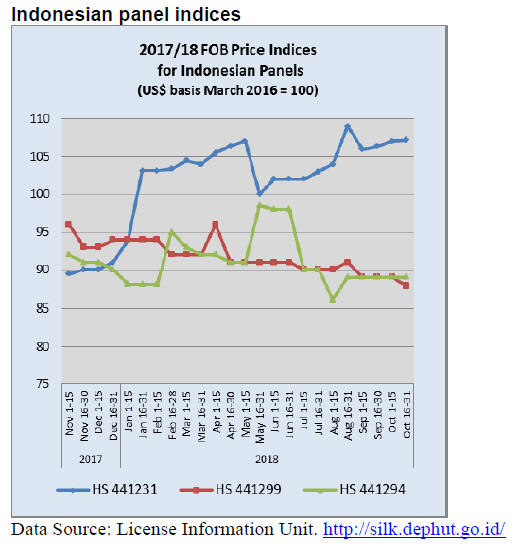
4.
MYANMAR
Old growth teak plantations
yield good quality logs
According to the local media, the Minister of Forestry
recently visited a sawmill where trials on old growth teak
thinnings were being conducted. The Minister was quoted
as commenting that he had noticed that the price of teak
logs from mature plantations is very attractive. This,
according to the Minister, could give a boost to investment
in teak plantations in the country.
Analysts write that it is believed the teak logs in the trial
were harvested from very old plantations which had
almost reverted to natural forest.
News awaited on options for MTE restructuring
The Myanmar government announced several years ago
that it plans to restructure the government-run Myanmar
Timber Enterprise (MTE) under private sector
management. It is understood that recently a representative
from the US Forest Service was in Myanmar to evaluate
the options for this restructuring. Analysts are yet to learn
of his recommendations.
The MTE has been responsible for managing log
extraction and for supplying teak and non-teak wood to the
private sector. It is unclear what form the restructuring
will be, all that is reported is that MTE will “operate under
a commercial model.”
Manufacturers plead for revision of taxes on timber
The MTE is among top state owned enterprise revenue
earners for the country. But domestic millers and
manufacturers are unhappy with the pricing structures
used by the MTE. According to manufacturers, MTE
timber prices include the 5% special commodity tax as
well as an extra ‘Commercial’ tax which brings the total
added to the log price to around 11%.
Manufacturers have urged the government and MTE to
eliminate the special commodity tax but this was refused
according to analysts.
FDI inflows drop
The World Bank has downgraded its economic growth
projection for Myanmar in fiscal 2018/19 ending on
March 31, to 6.2% from its original forecast of 6.8%.
The Bank attributes the change in forecast to mostly
domestic factors such as floods, inflation and the “Rakhine
crisis”.
According to the World Bank prospects are bleak. Foreign
Direct Investment (FDI) applications in the April-
September period totalled US$1.7 billion, compared with
US$3 billion during the same period last year.
Additionally, inflation is currently 8.5%, compared with
5.5% last year and the kyat has depreciated 25% in recent
months.
Strengthened environmental compliance
Bangkok-headquartered ‘SLP Environmental’ has
announced the extension of its environmental, health and
safety (EHS) compliance auditing services to cover
Myanmar. This comes after the company spent a year
compiling a comprehensive in-house database of the
existing legislation and statutory rules.
This comes as Myanmar prepares to enact new
occupational health and safety legislation which will apply
to businesses operating in multiple sectors throughout
Myanmar.
The SLP website says the company has an established
presence in Myanmar having assisted the Myanmar
Ministry of Environmental Conservation and Forestry
(MOECAF) to prepare environmental impact assessment
guidelines.
See: https://www.slpenvironmental.com/slp-environmentallaunches-
environmental-health-safety-ehs-legal-registercompliance-
auditing-services-myanmar/
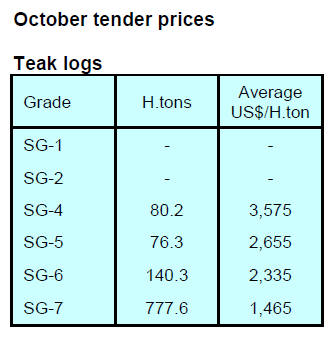
5. INDIA
Timber commodity prices move higher
India’s official wholesale price index for all commodities
(Base: 2011-12=100) for September 2018 released by the
Office of the Economic Adviser to the government rose to
120.8 from 120.0 for August. The annual rate of inflation
based on monthly WPI in September 2018 was 5.13%
compared to 4.53% for the previous month.
The September index for ‘Manufacture of Wood and of
Products of Wood and Cork‘ group rose to 133.7 from
132.8 for the previous month due to higher prices for
veneers and panel products, mouldings and plywood.
However, prices for wooden box/crates declined.
The press release from the Ministry of Commerce and Industry
can be found at: http://eaindustry.nic.in/cmonthly.pdf
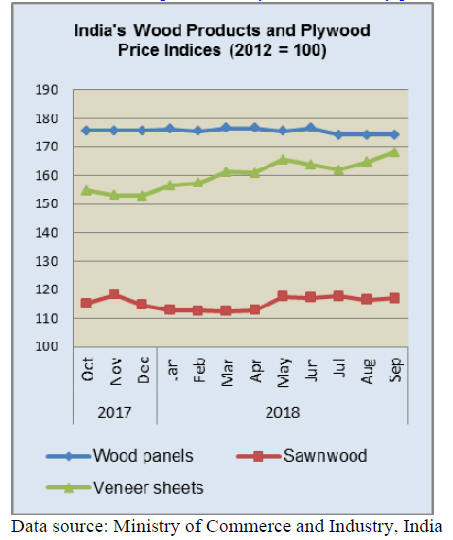
Indian Railways abandons wooden sleepers for
composite alternative
In what analysts call a misguided statement a
representative of Indian Railways said the decision to
switch to composite sleepers was in order to “become
more eco-friendly”.
The domestic press has quoted the Indian Railways as
announcing “the Railways prefer them (composite
sleepers) over wooden sleepers because of environmental
issues that cropped up over the cutting of trees, a decision
taken in the wake of a Supreme Court order imposing
restrictions on cutting trees”
Commenting on the manufacture of composite materials a
Railways spokesperson said fibre-reinforced foamed
urethane (FFU) composite sleepers are made of rigid
polyurethane reinforced with glass fibre a lightweight,
high-strength, environment-friendly product cost-effective
alternative to timber or concrete.
Plantation teak prices
Domestic demand for imported logs continues to improve
but exchange rate issues are of concern to importers. The
weak rupee has been pushing up landed costs but
fortunately, because of the firm market conditions,
importers have been able to pass on the higher costs to
domestic millers.
C&F prices in US dollars remain unchanged
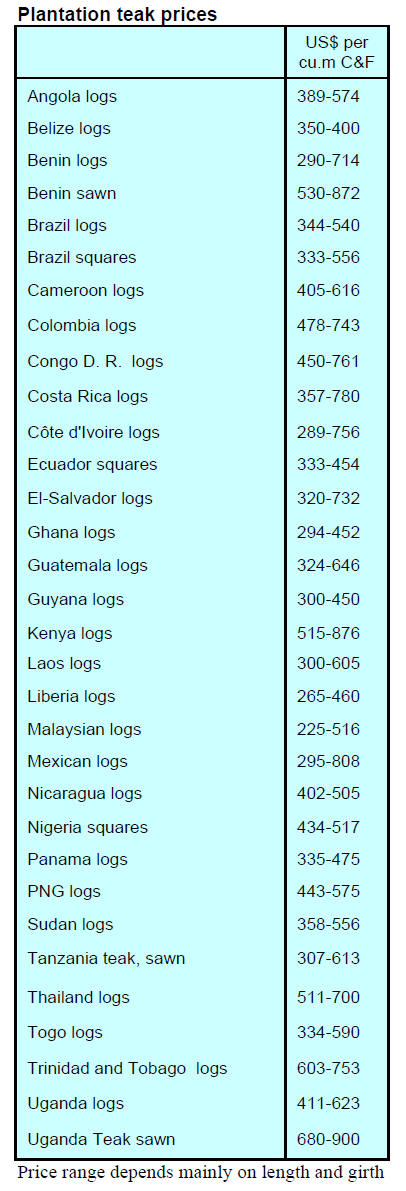
Locally sawn hardwood prices
Traders report demand is steady. The rupee landed cost for
imported hardwoods continues to rise because of the
weakening rupee so on-selling prices were raised some
weeks ago.
The industry is looking to the Reserve Bank to steady the
dollar/rupee exchange rate to avoid disruption to business.
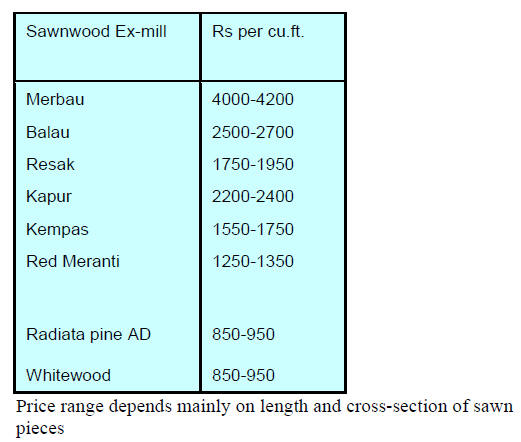
Teak stockists increase prices to take
advantage of
rising demand
Improved demand for but diminishing supply of Myanmar
teak has given Indian stockists the opportunity to raise
prices. However, the downside to this is that endusers are
now diverting attention to alternatives.
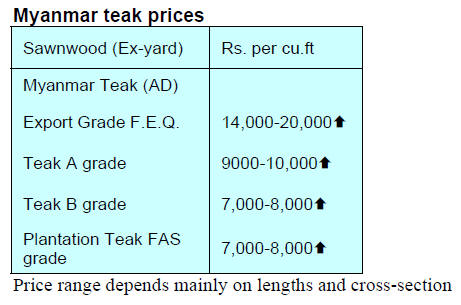
Sawn hardwood prices
Analysts report the recent price increases have been
accepted in the market.
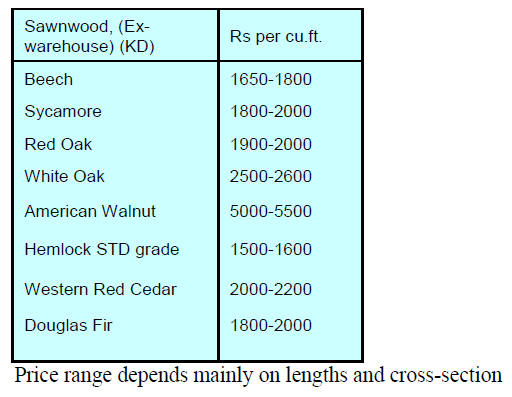
No respite from rising production costs
Indian plywood manufacturers report that their recent
prices increases have been absorbed by the market and
while this brought them some relief they are now facing
another problem.
Rising prices for petroleum products such as melamine,
phenol and formalin are pushing up production costs such
that the gains from recent plywood price increases are
being wiped out.
Adding to the woes of manufacturers in India are the
indications that the quantity of veneers being exported
from Gabon may be affected as the government in Gabon
is considering limiting the issue of veneer manufacturing
licenses. Indian analysts say it appears that veneer mills in
Gabon may have to invest to manufacture plywood.
Current India ex-mill prices for plywood are shown below.
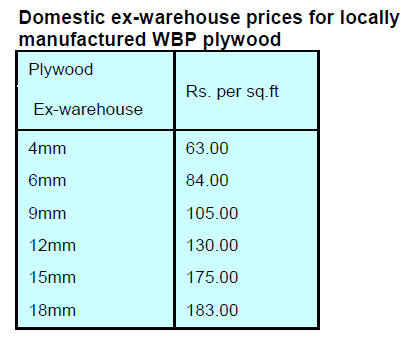
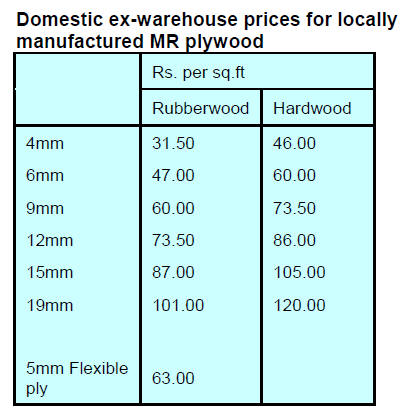
6. BRAZIL
Timber and construction
companies promoting
domestic timber use
In October this year the Wood Technology Reference
Center in the Institute for Technological Research (IPT)
brought together professionals and representatives from
the timber and construction industries to discuss
promoting greater use of wood in domestic construction.
Participants from different regions of the country (São
Paulo, Paraná, Mato Grosso, Rio Grande do Sul and Minas
Gerais) contributed to identifying what must be done to
expand the consumption of wood products in the domestic
construction sector.
During the event, five working groups were formed,
namely: Forests, Components, Education, Projects and
Construction. Among the topics that emerged were the
need to discuss fire regulations, the production of
documents and technical publications that can be used as
support materials in capacity building of professionals and
verifying the legality of raw materials.
Other aspects discussed were production of components;
capacity building for professionals in wooden structures;
aspects that should be considered in building design and
wood construction projects and prospects for construction
sector markets.
Fines levied but forest burning continues
There is an ongoing operation led by the Amazon
Environmental Protection Institute (IPAAM) and the State
Secretariat of the Environment (SEMA) to combat illegal
logging and forest clearing, particularly in the southern of
Amazonas.
Using SEMA satellite imagery the operation successfully
identified the sites of fires in the municipalities of Apuí
and Novo Aripuanã. These areas are considered a priority
for preventing deforestation and burning. The fires that
were detected resulted in the loss of around 1,500 ha. of
forest.
IPAAM has issued 40 environmental infractions totalling
more than R$9 million in fines and has also seized
illegally harvested logs in Novo Aripuanã and fined the
owner of the property R$1 million.
Export round-up
In September 2018 Brazilian exports of wood-based
products (except pulp and paper) increased 8.4% in value
compared to September 2017, from US$248.3 million to
US$269.1 million.
The value of pine sawnwood exports increased 20%
between September 2017 (US$41.9 million) and
September 2018 (US$50.4 million) and the volume of
exports increased 17% over the same period (202,500
cu.m to 237,700 cu.m).
Tropical sawnwood exports also increased rising 31% year
on year from 42,500 cu.m in September 2017 to 55,700
cu.m in September 2018. In terms of value, exports
increased 21% from US$19.5 million to US$23.5 million
over the same period.
September pine plywood exports increased 31% in value
year on year from US$48.7 million to US$63.6 million.
Export volumes also increased, rising 13% over the same
period, from 165,900 cu.m to 188,200 cu.m.
In contrast, tropical plywood exports declined 28% in
volume, from 16,300 cu.m (US$6.3 million) in September
2017 to 11,700 cu.m (US$5.5 million) in September 2018.
Brazil’s wooden furniture exports continue to do well and
in September 2018 totalled US$44 million compared to
US$40 million in September 2017 a 10% rise.
USA the top market for furniture from Rio Grande do
Sul
Manufacturers in Rio Grande do Sul account for most of
the wooden furniture production in Brazil. Between
January to August 2018 furniture manufacturers in the
State of Rio Grande do Sul exported mainly to the United
States and Uruguay (15% each) and the United Kingdom
(14%).
In August there was a 26% increase in furniture exports
from Rio Grande do Sul State compared to the previous
month. The value of these exports was US$17.8 million
according to IEMI - Market Intelligence Institute. The
president of the Furniture Industry Association of Rio
Grande do Sul (MOVERGS) has said his association is
pleased to see the increase in foreign currency earnings
which is a result of manufacturers beating the competition
in international markets.
But, there are challenges. As the currency weakens
manufacturing inputs such as imported components used
in the manufacture of furniture become more expensive
and planning production and pricing becomes a nightmare
if exchange rates are volatile.
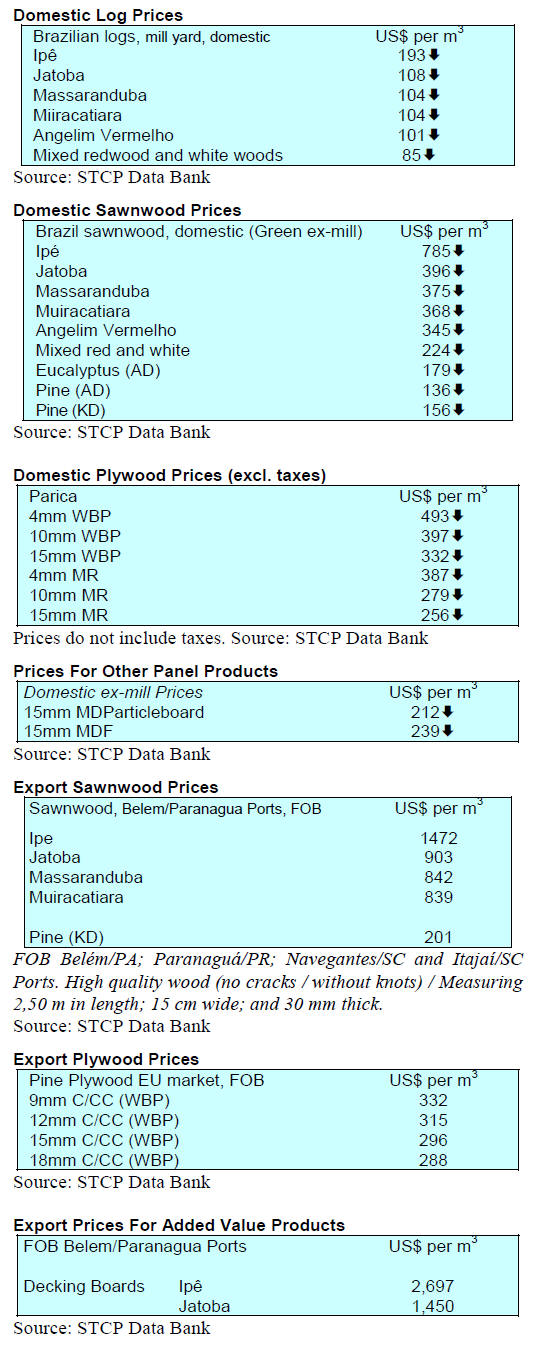
7. PERU
Timber exports set to rise after 5 years
After five consecutive years of decline Peruvian exports of
wood products seem set to rise this year. The Center for
Foreign Trade (CCEX) of the Chamber of Commerce in
Lima has forecast exports to come in at US$123 million
which would be slightly more than in 2017. Between
2013-2017 timber exports dropped around 5% annually.
The better performance is the result of higher demand for
manufactured products such as flooring, furniture and door
sets.
CCEX has reported that in the first eight months of this
year the timber sector registered a positive performance
with export shipments reaching US$79 million, a 3% rise
compared to the same period in 2017.
In 2017 Peruvian exports of wood totalled US$121
million, down 6% compared to 2016. In that year the main
products exported were semi-manufactured items (US$85
million), approximately 70% of all wood product exports;
sawn wood (US$ 24.4 million, 20%) and manufactured
products (US$ 12.1 million 10%).
The main export markets in 2017 were China at US$59
million (parquet strips, moldings and sawnwood) followed
by Mexico US$18 million (mainly virola, imbuia and
balsa sawnwood and plywood; United States US$12
million (mainly flooring and furniture).
Particleboard imports higher in July
In July 2018 Peruvian imports of particleboard amounted
to US$9.7 million, an increase of 24% compared to the
same month in 2017.
Most of the increase was accounted for by higher
shipments from Chile (US$3.8 million in July 2018 cf.
US$1.9 million in 2017) followed by Ecuador, US$3
million (2017: US$3.8 million), Spain, US$1.5 million and
Brazil, with US$1.3 million.
Regional governments informed of SERFOR
sanctioning powers
SERFOR, along with the Forest Resources Oversight
Agency (OSINFOR), the Regional Governments of
Ucayali, Loreto, Amazonas and Forest Support
Programme of the United States Agency for International
Development (USAID) and the United States Forest
Service (USFS), have established a task force whose aim
is to instruct regional forest administrations on the powers
given to SERFOR through the Administrative Sanctioning
Procedures (PAS).
A training programme was conducted with the regional
governments of Loreto, Ucayali and Amazonas to explain
the PAS. This programme for the regional forestry
authorities included delivering guidance on the scope of
the sanctioning powers of SERFOR.
SERFOR Board shares experiences with US Forest
Service
With support from the United States Forest Service and
the United States Agency for Development (USAID)
through its ‘Forest’ Programme’ the SERFOR board of
directors exchanged experiences and ideas on optimising
the performance, function and efficiency of forest
governance in Peru. This effort was undertaken as it is in
line with Peru’s Agrarian Policy which promotes the
sustainable use of forest resources and wildlife.
It is the function of the Ministry of Agriculture and
Irrigation (MINAGRI) to strengthen the country's forest
governance in order to improve the conditions for the
development of forest management and transformation of
production and trade.
This exchange provided an opportunity to consider
different management models and lessons learned in forest
management and the collaborative work by the different
entities.
One focus was on the relationship with the communities
and indigenous peoples where it was recognised there is a
need to enhance the collaborative and integrative approach
in the development of policies for the proper management
of forest resources of Peru.
During one of the dialogues a representative of USAID
informed the SERFOR Board of Directors on an ambitious
project called "Green Amazon", which could contribute to
the strengthening of forest management in the tropics.
